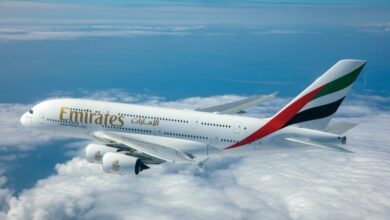Emirates to fly A380 fleet in full force by end of 2023 as travel rebounds

Emirates, the world’s biggest operator of the Airbus A380, plans to return its full fleet of superjumbos into service by the end of next year as it ramps up operations to meet strong demand for air travel.
The Dubai-based airline’s capacity has recovered to 80 per cent of its pre-pandemic levels, while its vast network has returned to 95 per cent of its pre-crisis size, Adnan Kazim, Emirates’ chief commercial officer said on Thursday, at the Skift Global Forum East in Dubai.
“Closer to the end of next year, that’s our target to bring back all our A380s back to operation … and recover the remaining 20 per cent of the capacity,” he told reporters on the sidelines of the two-day travel event.
The long-haul giant’s move comes as international borders have reopened and Covid-19-related restrictions have eased.
Emirates currently operates about 85 of the four-engine aircraft, gradually returning them to service after grounding most of its 116 A380s during the height of the Covid-19 crisis that brought air travel to a near standstill. Of the remaining A380s, some are under maintenance, others are earmarked for retrofitting and the remainder will return to the skies.
Emirates has embarked on a $2 billion two-year programme to retrofit its cabin interiors for A380s and 777s, phasing them out later than planned to cope with the delayed delivery of its new Boeing 777X wide-body aircraft.
Beyond the recovery to 2019 levels, the airline is planning ahead for full growth starting in 2024 as it prepares to take the first deliveries of the twin-aisle Airbus A350 jets in August 2024 — which adds a new aircraft type to its fleet mix — and the long-delayed Boeing 777X wide-body in mid-2025.
The airline is also tapping codeshare agreements to expand its network, most significantly a deal with United Airlines signed in September.
Codeshares are business arrangements in which two airlines agree to market and publish a particular flight as part of their own schedule or timetable. Only one airline operates the flight, but the other airline can add its own unique flight number for marketing purposes and frequent-flyer programmes. Airlines use such pacts to expand their networks for little extra cost.
The airline is aiming to hire an additional 400 pilots and 5,000 to 6,000 cabin crew by the middle of next year, recruiting to the maximum capacity of its training facilities, Emirates’ chief operating officer Adel Al Redha told The National at the Bahrain International Airshow last month.
This will swell its current workforce of 4,500 pilots and 17,500 cabin crew.




